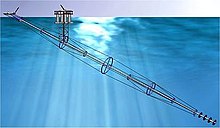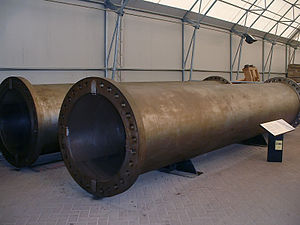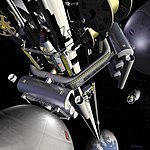
In celestial mechanics, an orbit is the curved trajectory of an object such as the trajectory of a planet around a star, or of a natural satellite around a planet, or of an artificial satellite around an object or position in space such as a planet, moon, asteroid, or Lagrange point. Normally, orbit refers to a regularly repeating trajectory, although it may also refer to a non-repeating trajectory. To a close approximation, planets and satellites follow elliptic orbits, with the center of mass being orbited at a focal point of the ellipse, as described by Kepler's laws of planetary motion.

A mass driver or electromagnetic catapult is a proposed method of non-rocket spacelaunch which would use a linear motor to accelerate and catapult payloads up to high speeds. Existing and contemplated mass drivers use coils of wire energized by electricity to make electromagnets, though a rotary mass driver has also been proposed. Sequential firing of a row of electromagnets accelerates the payload along a path. After leaving the path, the payload continues to move due to momentum.

In celestial mechanics, escape velocity or escape speed is the minimum speed needed for a free, non-propelled object to escape from the gravitational influence of a primary body, thus reaching an infinite distance from it. It is typically stated as an ideal speed, ignoring atmospheric friction. Although the term "escape velocity" is common, it is more accurately described as a speed than a velocity because it is independent of direction. The escape speed is independent of the mass of the escaping object, but increases with the mass of the primary body; it decreases with the distance from the primary body, thus taking into account how far the object has already traveled. Its calculation at a given distance means that no acceleration is further needed for the object to escape: it will slow down as it travels—due to the massive body's gravity—but it will never quite slow to a stop. On the other hand, an object already at escape speed needs slowing for it to be captured by the gravitational influence of the body.

A projectile is an object that is propelled by the application of an external force and then moves freely under the influence of gravity and air resistance. Although any objects in motion through space are projectiles, they are commonly found in warfare and sports.

In astronautics, the Hohmann transfer orbit is an orbital maneuver used to transfer a spacecraft between two orbits of different altitudes around a central body. Examples would be used for travel between low Earth orbit and the Moon, or another solar planet or asteroid. In the idealized case, the initial and target orbits are both circular and coplanar. The maneuver is accomplished by placing the craft into an elliptical transfer orbit that is tangential to both the initial and target orbits. The maneuver uses two impulsive engine burns: the first establishes the transfer orbit, and the second adjusts the orbit to match the target.

A geostationary transfer orbit (GTO) or geosynchronous transfer orbit is a type of geocentric orbit. Satellites that are destined for geosynchronous (GSO) or geostationary orbit (GEO) are (almost) always put into a GTO as an intermediate step for reaching their final orbit.

Orbital mechanics or astrodynamics is the application of ballistics and celestial mechanics to the practical problems concerning the motion of rockets, satellites, and other spacecraft. The motion of these objects is usually calculated from Newton's laws of motion and the law of universal gravitation. Orbital mechanics is a core discipline within space-mission design and control.
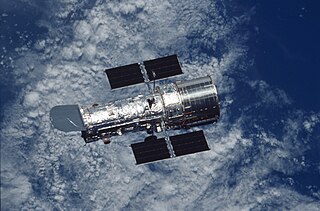
Astronautics is the practice of traveling beyond Earth's atmosphere into outer space. Spaceflight is one of its main applications and space science is its overarching field.
Delta-v, symbolized as and pronounced delta-vee, as used in spacecraft flight dynamics, is a measure of the impulse per unit of spacecraft mass that is needed to perform a maneuver such as launching from or landing on a planet or moon, or an in-space orbital maneuver. It is a scalar that has the units of speed. As used in this context, it is not the same as the physical change in velocity of said spacecraft.

From the Earth to the Moon: A Direct Route in 97 Hours, 20 Minutes is an 1865 novel by Jules Verne. It tells the story of the Baltimore Gun Club, a post-American Civil War society of weapons enthusiasts, and their attempts to build an enormous Columbiad space gun and launch three people — the Gun Club's president, his Philadelphian armor-making rival, and a French poet — in a projectile with the goal of a Moon landing. Five years later, Verne wrote a sequel called Around the Moon.
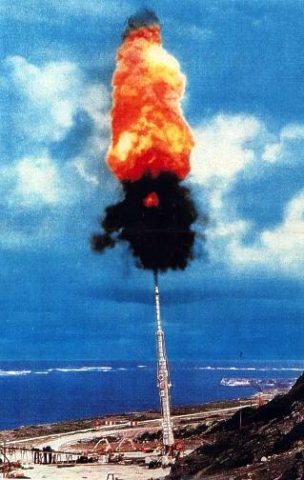
Project HARP, short for High Altitude Research Project, was a joint venture of the United States Department of Defense and Canada's Department of National Defence created with the goal of studying ballistics of re-entry vehicles and collecting upper atmospheric data for research. Unlike conventional space launching methods that rely on rockets, HARP instead used very large guns to fire projectiles into the atmosphere at extremely high speeds.

A sub-orbital spaceflight is a spaceflight in which the spacecraft reaches outer space, but its trajectory intersects the surface of the gravitating body from which it was launched. Hence, it will not complete one orbital revolution, will not become an artificial satellite nor will it reach escape velocity.
A geocentric orbit, Earth-centered orbit, or Earth orbit involves any object orbiting Earth, such as the Moon or artificial satellites. In 1997, NASA estimated there were approximately 2,465 artificial satellite payloads orbiting Earth and 6,216 pieces of space debris as tracked by the Goddard Space Flight Center. More than 16,291 objects previously launched have undergone orbital decay and entered Earth's atmosphere.

In astrodynamics and aerospace, a delta-v budget is an estimate of the total change in velocity (delta-v) required for a space mission. It is calculated as the sum of the delta-v required to perform each propulsive maneuver needed during the mission. As input to the Tsiolkovsky rocket equation, it determines how much propellant is required for a vehicle of given empty mass and propulsion system.

Spacecraft flight dynamics is the application of mechanical dynamics to model how the external forces acting on a space vehicle or spacecraft determine its flight path. These forces are primarily of three types: propulsive force provided by the vehicle's engines; gravitational force exerted by the Earth and other celestial bodies; and aerodynamic lift and drag.
The Super High Altitude Research Project was a U.S. government project conducting research into the firing of high-velocity projectiles high into the atmosphere using a two-stage light-gas gun, with the ultimate goal of propelling satellites into Earth orbit. Design work on the prototype space gun began as early as 1985 at the Lawrence Livermore National Laboratory in California and became operational in December 1992. It is the largest gas gun in the world.

Around the Moon, also translated as Circling the Moon and All Around the Moon, is the sequel to Jules Verne's 1865 novel, From the Earth to the Moon. It is a science fiction tale which continues the trip to the Moon that was only begun in the first novel. Later English editions sometimes combined the two under the title From the Earth to the Moon and Around It.
Spacecraft collision avoidance is the implementation and study of processes minimizing the chance of orbiting spacecraft inadvertently colliding with other orbiting objects. The most common subject of spacecraft collision avoidance research and development is for human-made satellites in geocentric orbits. The subject includes procedures designed to prevent the accumulation of space debris in orbit, analytical methods for predicting likely collisions, and avoidance procedures to maneuver offending spacecraft away from danger.

Non-rocket spacelaunch refers to theoretical concepts for launch into space where much of the speed and altitude needed to achieve orbit is provided by a propulsion technique that is not subject to the limits of the rocket equation. Although all space launches to date have been rockets, a number of alternatives to rockets have been proposed. In some systems, such as a combination launch system, skyhook, rocket sled launch, rockoon, or air launch, a portion of the total delta-v may be provided, either directly or indirectly, by using rocket propulsion.
Quicklaunch is a currently inactive company attempting to use a type of space gun to launch payloads into low Earth orbit. It is a university spin-off of the SHARP project which ended 2005.
